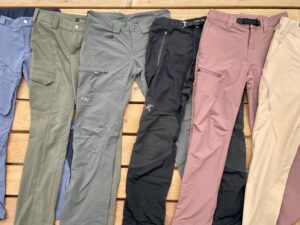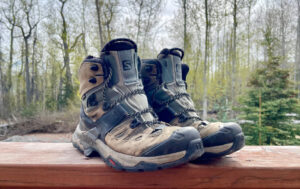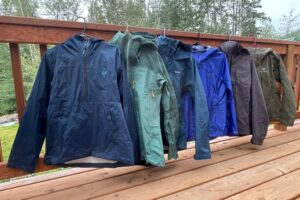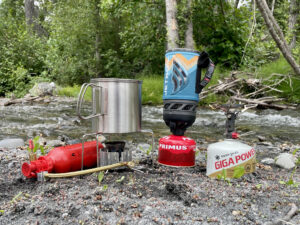If you’ve graduated from the resort slopes and prefer to get your adrenaline pumping on backcountry trails, an avalanche beacon is an essential piece of survival gear.
Carrying and knowing how to use proper avalanche safety tools such as a beacon, shovel, probe, or even an airbag pack is vital for excursions into avalanche terrain. In addition to bringing the necessary tools, you should only enter terrain appropriate for your current skills and education.
If you are getting ready to dive into backcountry skiing or want to replace your existing beacon, read on to learn about the best avalanche beacons.
The best avalanche beacons
Editor’s pick: Ortovox Diract Voice Avalanche Transceiver

- Multiple burial function
- Extra grip and single button function for use with gloves
- Digital range 50m
- Voice navigation
- Larger LED display
- Waterproof housing
Pros
- Voice navigation in combination with screen directions can help a rescuer stay calm and potentially find a buried victim more quickly
- Beacon can locate multiple signals in a 50m area
- Switches automatically into transmit mode in case of a secondary avalanche
Cons
- Quite expensive
- Rechargeable battery isn’t ideal for big expeditions if you don’t have a way to recharge it
The Ortovox Diract Voice Avalanche Transceiver is our editor’s choice, top pick, and my personal favorite beacon for backcountry use. While I thankfully haven’t had to use this device to uncover a friend, it’s had impeccable accuracy while practicing skills with friends.
The hallmark feature of this beacon is that when in search mode, it helps navigate via voice commands, which can help combat the fight, flight, or freeze response in a true emergency scenario. The voice directions, in addition to reading navigation directional arrows on the screen, can help the user stay calm and focus on the task.
This beacon is easy to use, with extra grips on the side and a single-button operation that can be used while wearing mittens. The large LED display is easy to see. This beacon can also look for up to four buried beacons over 50m if a group has been hit by an avalanche. In the event of a secondary avalanche, the transceiver will automatically switch to transmit. This beacon comes with a harness to keep it securely on your body.
See Ortovox Diract Voice Avalanche Transceiver on Amazon
See Ortovox Diract Voice Avalanche Transceiver on REI
Great starter beacon: Backcountry Access Tracker S Avalanche Transceiver
![]()
- Signal suppression mode for multiple burials
- Works on three AAA batteries so you can carry extras and replace them
- 200-hour battery life in transmit mode
- Max range 55m
Pros
- Great budget model for recreational backcountry users
- Decent battery life
- Top-of-the-line budget beacon
- Simple and easy to use for new backcountry users
Cons
- Battery life isn’t ideal for professionals
- Screen might be hard to read in certain conditions
The Backcountry Access Tracker S is BCA’s most basic avalanche transceiver, but it’s still a great option for a “budget” beacon. It has most of the technology of the Tracker 3 and 4 but lacks motion sensing or upgradeable software.
The three-antenna beacon features a temperature-resistant LED screen that, when in receive mode, displays the distance in meters from a beacon in transmit mode. The Tracker S can be put into auto-revert mode by holding down the option button while turning on the device. Auto revert mode makes the beacon revert back to TR (transmit) after five minutes in search mode. That’s useful if you’re searching for a buried beacon in avalanche terrain in the case of a second avalanche that could bury your beacon.
You can also turn on signal suppression mode by pressing the option key while in search mode. Signal suppression suppresses the strongest signal and points to the second strongest signal, useful in the case of multiple burials. If you continue holding down the option button, it will turn to big picture mode, where you will pick up all signals. The Tracker S takes three AAA batteries and comes with a harness.
Our tester has used the Tracker S as their primary beacon for the past two years of backcountry travel and finds it to be everything they need as a casual backcountry enthusiast. It doesn’t have every feature that an avalanche professional would need, but it is sufficient for most people. It’s affordable, lightweight, and easy to use. They found it accurate while practicing beacon searches, but have never used it for a real incident.
See Backcountry Access Tracker S Avalanche Transceiver on Amazon
See Backcountry Access Tracker S Avalanche Transceiver on REI
Great bang for your buck: Backcountry Access Tracker3 Avalanche Beacon
![]()
- Pocket-friendly beacon
- Maximum range 55m
- Real-time display screen
- Runs on three enhanced receivers
- Runs on three AAA batteries
Pros
- Super-small and lightweight
- Comfortable and easy-to-use
- Runs on AAA batteries
Cons
- Not rechargeable
- Only works in open spaces
The Backcountry Access Tracker3 Avalanche Beacon is an upgrade to the Backcountry Access Tracker2. This is roughly 20% smaller and lighter than the Tracker2. An up-to-date display and an additional receiving antenna have been added (giving it three receiving antennas).
This pocket-friendly tracker is ideal for anyone who loves to spend time in the backcountry. It runs on three AAA-sized batteries. This poses both advantages and disadvantages. You will be able to plan well with a lot of spare batteries but one could argue that the price of purchasing these batteries compared to how long they last make it more expensive than a chargeable version.
See Backcountry Access Tracker3 Avalanche Beacon on Amazon
Best for guides and professionals: Mammut Barryvox Beacon
![]()
- 70m search strip width
- Three antenna beacon
- Multiple burial flagging function
- Acoustic navigation
- Goggle and polarized sunglasses-friendly screen
- Shockproof and breakproof housing
Pros
- Excellent visibility
- Easy to use after a couple of outings
- Excellent search range
Cons
- Takes a few uses to get to grips with
- Difficult to operate with mittens
We love the Mammut Barryvox Beacon for guides and professionals for its search range and highly visible screen. The goggle and polarized sunglasses-friendly display is quite large and easy to view. We also love the 70m digital range and the circular receiving field. There is also voice search assistance.
It may take a few uses to get the hang of this transceiver but once you do, users report it’s quite simple to move from transmit to search mode and to do group checks. This is one of the most capable beacons out there, with an excellent search range and a host of features to help keep you safe in the backcountry.
See Mammut Barryvox Beacon on Amazon
See Mammut Barryvox Beacon on Cripple Creek Backcountry
Great for multiple burial scenarios: Arva Neo BT Pro Beacon
![]()
- Large search strip width, up to 90m
- Analog mode and digital mode
- Multiple burial function
- Triple antennas
- Signal suppression function
Pros
- Lots of excellent features
- Huge search range
- Excellent performance when dealing with multiple buried victims
Cons
- Lower-end models have significantly fewer features
- Buttons on side could be triggered by movement
- Takes time to learn all the features
The Arva Avalanche Transceiver series is a relatively new line to most folks, with an impressive line of features. Here, we look at the Neo BT Pro, Arva’s top-of-the-line beacon, an excellent choice for backcountry users of all levels.
One feature that makes Arva’s avalanche transceivers stand out is the search range. The Neo BT Pro has an impressive 80m strip search width when in digital mode and 90m in analog mode. Additionally, it’s Bluetooth compatible, offers automatic analog mode, standby mode, interference management, a backlit screen, and a scrolling function. This is all in addition to the multiple burial indicators, triple antennas, and group check functions.
See Arva Neo BT Pro Beacon on Backcountry
Why trust us
Writing a guide about avalanche beacons is always a bit harrowing. No one likes to think about digging their friends out from under the snow. The beacons in this review were heavily researched to ensure there were no active recalls, poor customer reviews, or general concerns about their functions. Two of the five models also had in-house testers, with a third having a tester of an upgraded model. Our testing team thankfully hasn’t had to pull anyone out of the snow with their beacons but each of us has put in plenty of practice days and has several years of backcountry experience.
Who this is for
This guide is for anyone looking for an avalanche beacon. Whether you’re looking for a replacement for an outdated, lost or broken model, or you’re looking to replace your old basic or analog beacon with one of the modern avalanche beacons.
How we picked
Selecting the best avalanche beacons isn’t merely a matter of personal preference, it’s a matter of safety, and at times, life and death. We made sure all beacons on this list were free of current recalls and had excellent reviews, safety ratings, and performance in the backcountry.
How we tested
Our avalanche beacon testing involved three different people in three different parts of the country. I tested the Ortovox Diract Voice both on tours in avalanche terrain and on skills days here in the Pacific Northwest. Thankfully, I haven’t had to use it to pull a buried friend, but we did practice digging out buried beacons on our skills days. Sean, our editorial director, and Ilana, one of our freelancers, also contributed to this guide testing the Tracker 4 and Tracker S respectively in different parts of Colorado on ski tours and on skills days. Cumulatively, we’ve spent well over a decade backcountry skiing and exploring the mountains around our homes.
![]()
Features to look for in avalanche beacons
Before making your final choice between the best avalanche beacons, consider these important features.
Digital vs analog transceivers
Snowboarders and skiers prefer digital beacons as they are easier to use and more readily available. However, if you’ve always used an analog beacon, you may not want to make the switch. Choosing whichever option you are most comfortable using is the most important thing.
Screen
A clear and easy-to-read screen is essential, especially if the conditions are harsh and overcast. It’s also useful to have backlight functionality.
Range
Maximum range is another important feature, however, it’s arguably not as essential as the speed of locating your partner. Still, it’s easy to get separated when on the slopes, so a wide range is useful. A typical beacon will range between 30 and 40 meters, but others provide a circular range of 50 meters, too.
Batteries
Most products run on AAA batteries, but this may vary between brands. Even the basic beacons usually come with batteries included. Some beacons are rechargeable, so make sure yours is charged before your outing or bring a power bank.
Multiple victims features
If you’re part of the rescue team searching for multiple victims, see if Flagging, Marking, or Masking features are available to locate every victim in your range. This will give you the best chance of finding everyone and ensure you can give them an airway before they run out of time.
In actual rescue scenarios, it’s not right to find and leave, so you must work quickly to ensure everyone survives. It’s a lot of pressure, we know, but that’s part of the job. Hopefully, in multiple burial scenarios, you also have multiple rescuers, but each scenario and situation is different and it could be down to one person to save the lives of all their friends.
RECCO
The RECCO system is a power and activation-free way to find people in avalanches, but only if they have RECCO-ready reflectors on their snow gear. We go into greater detail about this further down, but an avalanche beacon with RECCO compatibility can increase your chances of locating victims if there is no transmission signal available.
![]()
Avalanche beacon FAQ
Q: Are all avalanche beacons compatible?
Yes, or at least all beacons made in the last 15 years are, as they all operate on 457 kHz frequency to allow interchangeability. However, those older than 15 years use two separate standard frequencies: one for Europe and one for North America.
Q: How do avalanche beacons work?
An avalanche beacon, which you might also see called an avalanche transmitter or avalanche transceiver, works by both broadcasting a signal and searching for radio waves to connect. Much like typical radio waves and frequencies, they can connect to other radio devices using this transmission.
To make it easier for you to find or be found, official avalanche beacons will beep louder or faster (or both) as the signal strength increases. You may also have a directional number on your device, which measures how far away the victim is. When the number cannot get any smaller, you know you have found your target and can begin the extraction process.
Q: Do avalanche beacons save lives?
They have been proven to save many, many lives since their introduction in 1968.
Despite this, as identified on Avalanche.org, they are only truly effective when used by people who practice with them regularly, and the proportion of people who practice frequently is lower than it could be. Because of this, the survival rate of avalanche victims using transceivers is not as high as one would hope.
For those who practice with their avalanche beacon regularly, though, the survival rate is high, so if you are considering investing in one, it pays to know how to use it and to run drills to ensure you can use it correctly.
Around a quarter of people caught in an avalanche will die from collisions with trees and rocks on the way down. Therefore, an avalanche beacon can only help the three-quarters of riders who survive the fall.
Q: How does the RECCO system work?
The RECCO system is another method for finding people buried in an avalanche. It comprises two parts, a RECCO detector which the rescuers use, and the RECCO reflector which is fitted to your ski jacket or pants.
The reflector is a small antenna that emits a radio signal and bounces a signal back between the detector to help them find you. The biggest benefit of the RECCO system is that it requires no power or activation to work.
Across the globe, there are over 800 ski resorts and search and rescue teams that use the RECCO system.
However, just because you have a RECCO system doesn’t mean you shouldn’t still take an avalanche transceiver with you, most rescue teams will search for both to locate you.
Sources:
- How To Choose An Avalanche Beacon – Outdoor Gear Lab
- 5 Features To Look For In An Avalanche Transceiver – Onboard Mag
- Avalanche Beacon (Transceiver) – Avalanche
- 7 Points To Explain The RECCO Rescue Technology – RECCO






